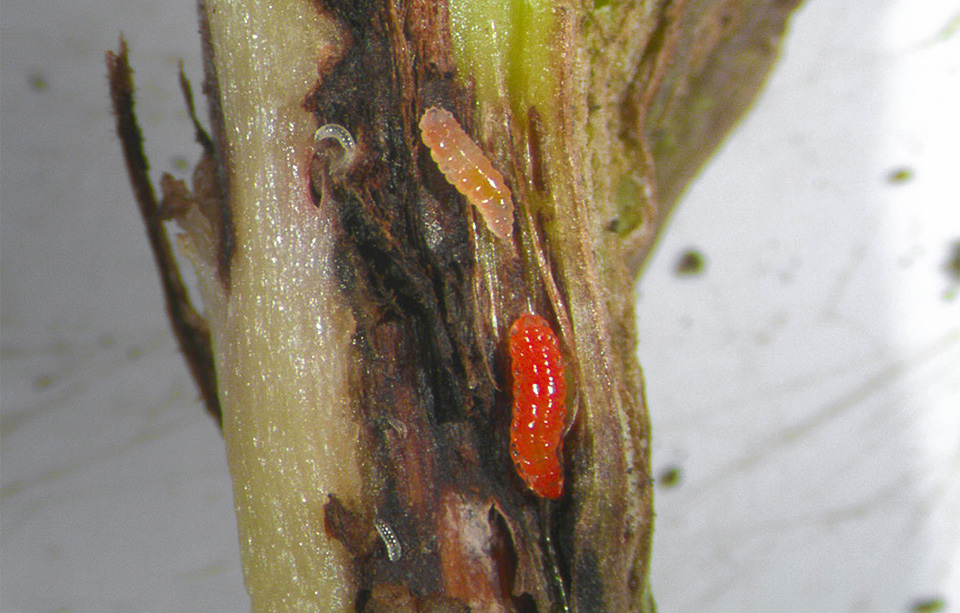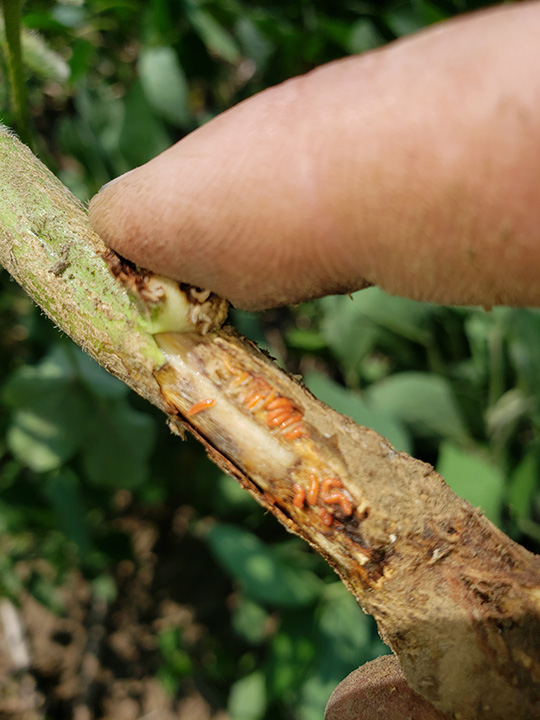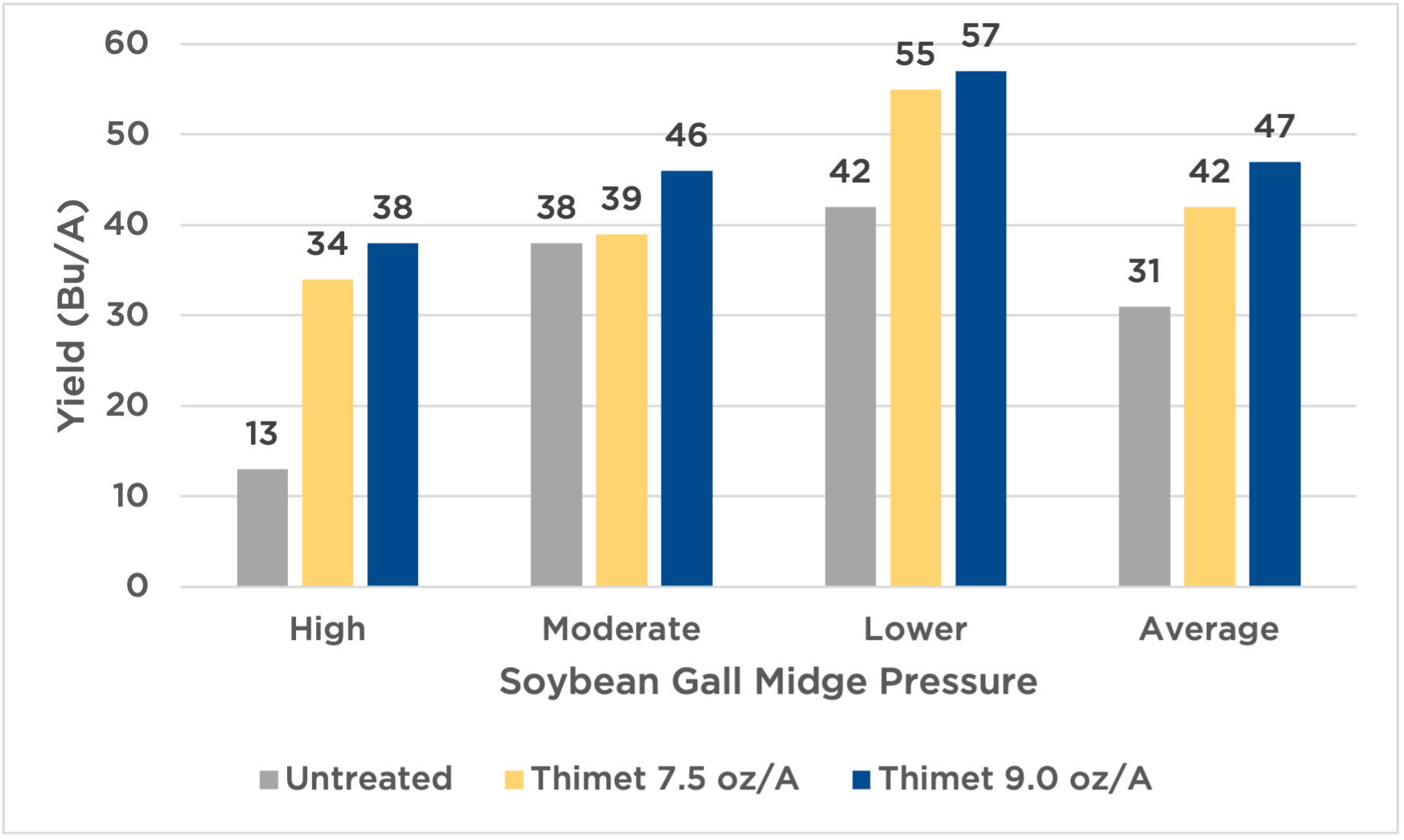
(Photo: Iowa State University / Erin Hodgson)
Management of soybean gall midge in Iowa
October 1, 2023
By Scott Nelson, Agronomist
Soybean gall midge is a relatively new species of soybean pest spreading in Iowa. Reports of potential soybean gall midge injury in the far western parts of Iowa were noted as early as 2016, with Iowa State University confirming soybean gall midge spreading as far east as I-35 with new confirmations in Marion County in 2023. Kansas, Missouri, Minnesota, Nebraska and South Dakota also face severe pest outbreaks.
A field perspective
Through his normal scouting routine, Dennis Reinke, sales agronomist for NEW Cooperative, Inc., found soybean gall midge had invaded soybean fields in his territory.
While Reinke and other producers in the western part of the state have dealt with soybean gall midge in the past, this is the most widespread they have seen the pest.
Typically found in the field’s border near grassy areas, this year they located the soybean gall midge 150 feet from the border and in otherwise healthy plants.
“That was alarming to me,” says Reinke. “The fact that the pest was found in fields with no symptoms of yellowing or wilting leaves or dead plants, and we were still finding it.” This is the largest outbreak he has found in his area near Moville west to the Missouri river.
The soybean gall midge life cycle
Understanding the life cycle of soybean gall midge is crucial to managing this pest.
First-generation soybean gall midge emerges from the overwintering in grass waterways, fencerows and infested fields beginning in June and are weak flyers with a life cycle of three to five days.
The adults cannot penetrate soybean stems and lay eggs into cracks and wounds in the soybean plant. These eggs hatch into larvae, and the larvae feed on stem and root tissue, leading to plant death.
After feeding, the larvae pupate, fall into the soil and emerge as second-generation adults that spread further into the field. Most commonly, Iowa has two to three generations per year.

Foliar insecticides lack efficacy
Trials conducted by the Iowa Soybean Association (ISA), University of Nebraska and Iowa State University showed foliar insecticides that are currently available were ineffective at controlling soybean gall midge. In contrast, insecticide seed treatments have shown minimal efficacy. Currently, commercially available foliar applications of insecticides lack the needed suppression of this midge.
Soil-applied Thimet insecticide
Beginning in 2019, ISA also partnered with AMVAC Chemical Corp. to evaluate soil-applied insecticide Thimet at 7.5 and 9 ounces per acre at planting. In these trials, we observed healthier soybean plants along end rows where Thimet was applied at five locations in western Iowa. A follow-up small plot experiment in Iowa showed a four-bushel per acre yield advantage for applied Thimet at planting.
The University of Nebraska has researched soil-applied Thimet to suppress soybean gall midge. In Figure 1 is an adaptation of these results published by Justin McMechan (Evaluation of At-Planting Soil Treatment Thimet Against Soybean Gall Midge, 2020. Arthropod Management Tests, Volume 46, Issue 1, 2021). This study had three sites ranging from low, moderate and high populations of soybean gall midge. On average, Thimet increased soybean yield by at least 12 bushels per acre.
Thimet is hazardous and expensive, and the application requires a closed system. It is currently unclear whether the entire field requires treatment with Thimet as soybean gall midge begins feeding along the outer field. Farmers could plausibly realize economic suppression of soybean gall midge by only treating the perimeter, as shown in Figure 2. However, additional research on method, cost and overall usage is needed as the efficacy of this solution is still being determined, given reports of overwintering in the middle of fields.

Planting dates
Entomologists have documented more soybean gall midge abundance in April planted soybeans compared to late May. They observed that later planted soybeans are less affected by soybean gall midge. This may be related to a lack of suitable hosts when it emerges, fewer injury points on plants for entering, or another mechanism.
In ISA research, the yield advantage for soybeans planted in April compared to late May or early June planting is between 5 to 10 bushels per acre. Farmers may still consider later planting in fields with a history of soybean gall midge if severe damage occurs. It may take only a few seasons of later planting dates to reduce the pest’s populations. Planting dates are a highly active area of investigation, with the additional publication of more data on this concept expected.
Other practices
Soybean gall midge enters the soybean plant through cracks in the stems. In university trials, hilling or burying the stems without burying the plant has effectively managed gall midge.
Some farmers have merged fields to reduce grass waterways or fence rows to reduce refuge for soybean gall midge with some success. However, waterways established to control erosion should be protected.
Conclusions
Scientists have learned much about soybean gall midge and have made substantial progress. We remain hopeful that progress will continue until we have developed more feasible practices. In the near term, effective suppression of soybean gall midge may involve later planting dates in fields with a history of soybean gall midge or using soil-applied Thimet, though further research is needed.
Back